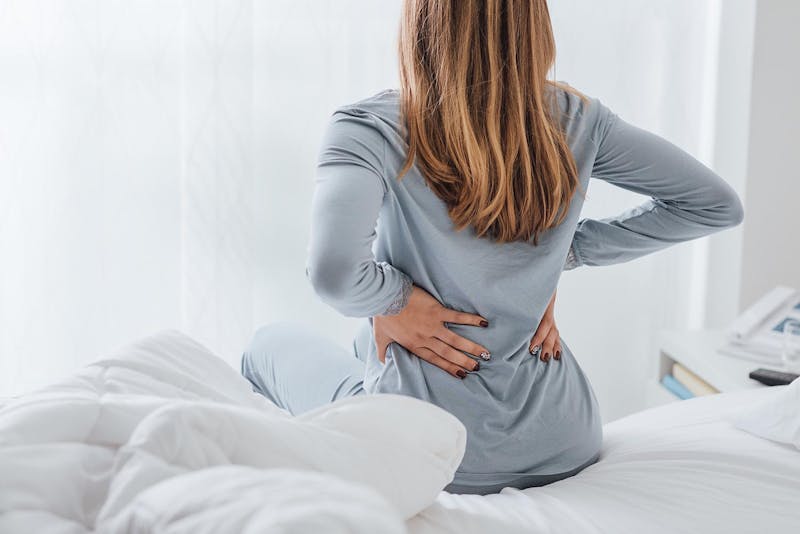
Dr. Lisa M. Jukes outlines the causes and treatment options for heavy menstruation and agonizing cramps.
Most women experience discomfort when Aunt Flo comes to visit. However, there are varying degrees of pain associated with menstruating, as it affects women differently depending on the symptoms and causes. Heavy menstruation and severe cramps not alleviated by a healthy lifestyle and use of over-the-counter pain relievers should be evaluated further by a specialist. When your body doesn’t respond to these tactics, it could potentially be more serious and even require surgery. Endometriosis, adenomyosis, uterine fibroid tumors, ovarian cysts, and prolapse are some of the common diagnoses for women suffering from pelvic pain and/or abnormal bleeding.
Most women experience discomfort when Aunt Flo comes to visit. However, there are varying degrees of pain associated with menstruating, as it affects women differently depending on the symptoms and causes. Heavy menstruation and severe cramps not alleviated by a healthy lifestyle and use of over-the-counter pain relievers should be evaluated further by a specialist. When your body doesn’t respond to these tactics, it could potentially be more serious and even require surgery. Endometriosis, adenomyosis, uterine fibroid tumors, ovarian cysts, and prolapse are some of the common diagnoses for women suffering from pelvic pain and/or abnormal bleeding.
WHAT ARE THE SIGNS OF AN ABNORMAL PERIOD?
“[One sign is] pain that doesn’t respond to Motrin, or [the patient] has to dose frequently and take several Motrin to be able to get relief and go about their normal activity,” Jukes explains. “As far as unusually heavy bleeding… changing a Kotex every hour or two…that would be considered not normal. Staining bedclothes at night or having to get up a couple of times in the night to change a Kotex would also be considered not normal.”
If your pain does not respond to various therapies (healthy diet, exercise, pain relievers, birth control), if you are bleeding between periods, experiencing a heavy flow or if your menstrual cycle is interfering with your quality of life, preventing you from going to work or leaving the house, then it is time to seek help from a women’s health professional.
WHY DO HEAVY MENSTRUATION AND CRAMPS OCCUR?
Painful menstrual cycles can occur as young as the early teenage years but tend to peak in a woman’s 20s and 30s. The painful symptoms typically go away with pregnancy and then oftentimes return for women in their 40s.
“Pregnancy can provide relief of symptoms from endometriosis and pelvic pain for several years,” Jukes explains.
Endometriosis is a condition in which endometrial type cells have implanted outside the uterus, causing severe cramps, abnormal bleeding and other pain, including pain with intercourse.
“Endometriosis can affect at least 25 percent of women,” Jukes says. “It can be genetic or even associated with congenital uterine anomalies. There’s a condition related to endometriosis called adenomyosis and that’s a common reason for severe menstrual cramps as well as heavy bleeding. It’s a condition where the endometrial lining has implanted in the muscle wall of the uterus.
“Pain can also be caused by uterine fibroids. Fibroids can cause bleeding problems if the fibroid is affecting the lining of the uterus,” Jukes says, further explaining that fibroids are benign, non-cancerous, fibrous-like tumors in the myometrium (muscle layer of the uterus).
Pelvic pain should be further investigated to assure that it is not related to a gastrointestinal, urologic or musculoskeletal disorder. Heavy bleeding can even start with a young woman’s first few menses. Up to 25 percent of these adolescents may have a hereditary bleeding disorder, which can be determined by simple blood work. Later on, heavy bleeding, bleeding between cycles or with intercourse can be secondary to overgrowth of the endometrium, uterine polyps, fibroids or adenomyosis.
WHAT ARE THE TREATMENT OPTIONS?
The first step would be to see how the body responds to pain relievers and possibly hormonal contraceptives. If the body is not responding, the next step is evaluation and possible ultrasound in order to determine the etiology.
“The treatment depends on what we find and whether that person wants to have children or has completed their family,” Jukes says. “If the findings are suggestive of endometriosis based on history and physical exam, then we typically proceed with a laparoscopy, which, in my experience, I prefer using da Vinci surgery.”
The da Vinci robotic system gives Dr. Jukes 3-D visualization, better magnification and the use of instruments that have more precise movements. Laparoscopy allows her to see into the abdomen through small incisions in order to diagnose what is causing the pain or bleeding. Dr. Jukes is now able to perform more complicated, minimally invasive surgeries rather than making large abdominal incisions, including single-site umbilical laparoscopic surgery. With da Vinci, patients experience less pain, less risk of infection and scarring, and shorter recovery time, among many other benefits.


